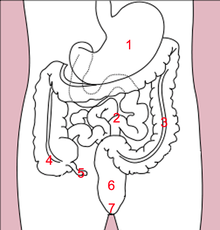Intestines
The intestine ( Latin intestinum , Greek ἔντερον, enteron ; also called intestines ) is the most important part of the digestive tract of higher multicellular animals including humans . It extends from the gatekeeper to the anus , in front of which are the stomach , esophagus and oral cavity . In adults, the intestine is about 5½ to 7½ meters long and has a surface area of about 32 m² because of the fine intestinal villi . The whole of the microorganisms in the intestine is the intestinal flora .
length
The length of the intestine depends in different animal species - especially in relation to the body length - mainly on the basic diet of the species. Meat eaters (carnivores) have a very short intestine because meat can be digested easily. Omnivore (omnivores) have longer intestines because plant food is digested more slowly. The longest intestines have herbivores (herbivores), because the digesting plant fibers (usually indirectly by means of unicellular symbionts required) much time.
The ratio of intestinal length to body length (head and torso without arms and legs) is around 4: 1 in humans (an omnivore) and is thus between that of a pure carnivore like the cat (3: 1) and that of a herbivore like the sheep ( 24: 1).
Subdivision of the intestine
The intestine is divided into the
- Small intestine (Latin intestinum tenue ), consisting of
- as well as the large intestine ( intestinum crassum ), consisting of
- Caecum ( cecum ) with said appendix (lat. Vermiform appendix , commonly falsely as "appendicitis" hereinafter), and
- Colon ( Greek -lateinisch Colon ) with ascending ( ascending colon ), querverlaufendem ( transverse colon ) descending ( the descending colon ) and S-shaped verlaufendem ( sigmoid colon , also called Sigma ) part,
- and the rectum ( rectal also) as rectum referred consisting of
- Pars ampullaris and anal canal ( Canalis analis ).
The rectum is followed by the anus (Latin for anus ), which, however, is not a part of the intestine in the narrower sense, as it is lined by the outer skin and not by the mucous membrane . The anus forms the continence organ with the terminal venous plexus of the rectum and the internal and external sphincter muscles .
Functions of the intestine
- Digestion and nutrient absorption
- Regulation of the water balance
- Development of a large part of the immune system's defense cells
- Production of hormones and messenger substances
Intestinal wall
The intestinal wall shows the typical three-layer structure of a membranous, muscular tube. The interior is lined by a mucous membrane (mucosa). A two-layer tunica muscularis , which consists of an inner ring and an outer longitudinal muscle layer, lies on the outside . The submucosal plexus is located between the mucosa and the muscle layer, the myenteric plexus between the two muscle layers - both parts of the intestinal nervous system . Outside - depending on the position of the intestinal section - either a tunica serosa or a tunica adventitia delimits the organ.
Examination options of the intestine
The intestine can partly be palpated and heard. Further diagnostic possibilities offered by ultrasound ( sonography ), contrast examinations , colonoscopy ( colonoscopy ) and computed tomography (CT) or magnetic resonance imaging (MRI). In addition, the small intestine and the large intestine can be examined through an endocapsule to be swallowed with a mini camera.
The examination of the stool, tissue sampling and blood tests provide further diagnostic information.
Common names
In the hunter's language , the willow intestine (especially the rectum ), urinary bladder and internal genital organs are called small sheaths .
Intestinal diseases and disorders
Enteropathy is the general name for a disease of the bowel
- Incorrect colonization of the small or large intestine
- Irritable bowel syndrome
- Infestation with intestinal parasites
- Inflammatory bowel disease
- Food intolerance
- Wind ( flatulence )
- Constipation ( constipation )
- Diarrhea (diarrhea)
- Familial adenomatous polyposis (FAP)
- Hermansky-Pudlak syndrome
- Colon tumors such as polyps ( e.g. familial adenomatous polyposis ), malignant tumors such as colorectal carcinoma
This list is not intended to be exhaustive.
See also
- Digestion - An excruciating method of execution
- Sausage casing made from natural casing
literature
- Giulia Enders : Gut with charm. All about an underrated organ. Ullstein, Berlin 2014, ISBN 978-3-550-08041-8 .
- Hans Adolf Kühn: diseases of the intestine. In: Ludwig Heilmeyer (ed.): Textbook of internal medicine. Springer-Verlag, Berlin / Göttingen / Heidelberg 1955; 2nd edition, ibid. 1961, pp. 804-841.
- N. Papastavrou: intestines. In: Surgery historically: beginning - development - differentiation. Edited by FX Sailer and FW Gierhake, Dustri-Verlag, Deisenhofen near Munich 1973, ISBN 3-87185-021-7 , pp. 107-131.
- Mary Roach : Gulp. On a journey of discovery through our digestive tract. From the American English by Katrin Behringer. Deutsche Verlags-Anstalt, Munich 2014, ISBN 978-3-421-04640-6 (original title: Gulp. ).
- Franz-Viktor Salomon: Gut, Intestinum (Enteron). In: Franz-Viktor Salomon, Hans Geyer, Uwe Gille (Ed.): Anatomy for veterinary medicine. 2nd, revised and expanded edition. Enke, Stuttgart 2008, ISBN 978-3-8304-1075-1 , pp. 293-311.
- Julia Seiderer-Nack: What happens in the intestine? New knowledge for better intestinal health. Intestinal barrier, abdominal brain, immune system and proper nutrition. Southwest, Stuttgart 2014, ISBN 978-3-517-08959-1 .
Web links
Individual evidence
- ^ Herbert F. Helander, Lars Fändriks: Surface area of the digestive tract - revisited. In: Scandinavian Journal of Gastroenterology. Vol. 49, No. 6, 2014, pp. 681-689, doi : 10.3109 / 00365521.2014.898326 .
- ^ Pschyrembel. Clinical Dictionary. De Gruyter, 255th edition, Berlin / New York 1986, ISBN 3-11-007916-X , p. 323.
- ^ German hunting lexicon: Gescheide .
